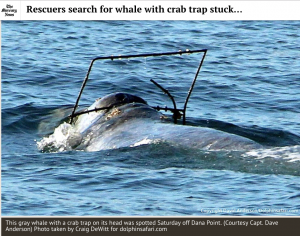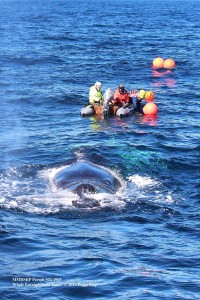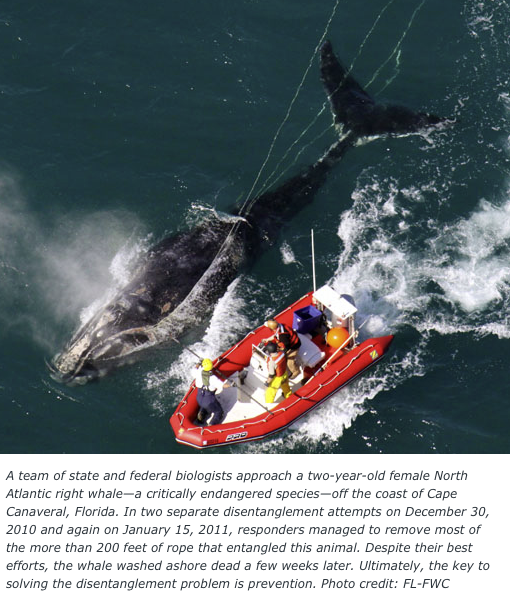
NOAA’s Entanglement Response Program
NOAA Fisheries and its Protected Resources Division (PRD) work to conserve and restore marine resources on the West Coast. Large whale entanglements are an important component of their overall conservation and recovery plans, and specifically addressed by the Entanglement Response Program.
The goals of the large whale entanglement response program are to gather information from entanglement events, increase public safety and awareness of the issue, ensure safety of responders through standardized training and set protocols, and ensure prevention measures are working.
The Entanglement Response Program is authorized under the Endangered Species Act and Marine Mammal Protection Act. During an entanglement event, a report of an entangled whale triggers a rapid response, a need to verify and assess the event, a possible attempt to disentangle, and documentation of the entire event. Many risks are assessed, including human and animal safety, vessel operations, and being able to implement standard protocols.
Responders are highly trained and use specialized equipment during an event. Partners during a response include personnel from NOAA, State agencies, Stranding Network members, academia, NGOs, whale watching companies, fishing community, private vessels and the USCG. Responders approach on a small boat and use techniques to minimize stress to the animal and ensure the safety of the operators. WET, the Whale Entanglement Team, is a group of 30 plus unpaid professionals (volunteers) assembled and trained for the purpose of disentangling whales.
In the future, efforts will continue to improve removal techniques, try to improve configurations of gear to reduce the likelihood of entanglements, increase eyes on the water, and grow the response network to decrease response time.
In March 2017, the West Coast Regional office of NOAA Fisheries updated their report on whale entanglements.
June 12, 2018 news article about entanglements in MBNMS. Statistics from the National Oceanic and Atmospheric Administration (NOAA) show a quickly evolving picture for entanglements:
- From 2000 to 2013, California averaged 10 reports of entangled whales per year.
- In 2015, there were 25 reports of entangled whales in Northern California alone—21 of those in the Monterey Bay—marking the highest tally since record-keeping began in 1982.
- In 2016, the number of reports climbed again, to 23 whales in the Monterey Bay alone.
- In 2017 there were 26 reported entanglements throughout California, still well above the historical average, according to NOAA data.
In Washington, Oregon and California, report whales in distress (injured, entangled, stranded or ship-struck) by calling (877) SOS-WHALE or (877) 767-9425. Try to capture an image or video and note location, time, date and nature of distress.
Brief overview of entanglement events prior to 2016
For the period from 2014 to July 2015, large whale entanglement events have been reported from Canada (British Columbia), Washington, Oregon and California. During that interval, BC reported 1, Washington 5, Oregon 7, and California 47 entanglement events. Of these reports, the confirmed entanglements were BC 1, Washington 3, Oregon 7, and California 35. Of the 35 confirmed events in California, 14 were in Monterey County, with the next largest number (n=5) was in LA county. In comparison, for the entire west coast from 1990 to 2009 the number of whale entanglement reports was about 10 per year.
What entangles these whales? In most cases, the actual source of the line or netting is not known. Rarely is a whale observed becoming entangled, and except in rare cases, lines do not have identifying markers on them (e.g., buoys, tags). In many locations where events occur, there are also fisheries that use lines and/or nets (e.g., crab and prawn traps, fish pots, and gillnets). There are also buoys placed in areas by researchers and agencies alike, particularly close to shore, that gather data or serve as navigational aides. Fisheries data from California in 2009 indicate that at least one humpback whale was definitely entangled in lines from spot prawn pots, Dungeness crab pots, and sablefish pots.
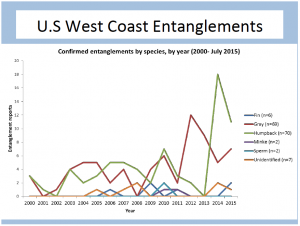
The recent spike in entanglement events is perplexing, and the numbers since 2010 are about 50% higher than the preceding 20 years. Are there actually more events, or is their greater awareness and more reporting? In addition to overall awareness and sensitivity by the public to this issue, there is a location bias: where there are more people recreating (e.g., Monterey Bay), there is a greater chance to see an entangled whale. Recent increases in whale populations are not at a rate that can explain the upswing in entanglements, but their behavior in recent years may be a contributing factor. Whales coming close to shore to feed enter a region prone to having more gear in the water. This change in foraging behavior could be part of the reason there are more whale-gear interactions. The other behavioral component is that of the fishing industry itself, which for certain sectors has seen an increase of landings taken from central California (largely Monterey county). This potential combination of more effort nearshore by both whales and humans may be a leading factor in the increase of entanglement events.
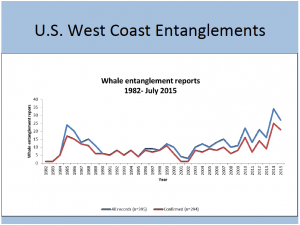
From 2000-2015 there have been 193 reported entanglements with live whales. Of those, 71 (36%) rescues were initiated by the response team. Of those, 25 were full releases (7 occurred without aid) and 13 were partial releases. Thirty-seven (37) were unsuccessful either because the whale was not located, conditions were too dangerous for the whale and/or responders, or it was determined that there was no need for intervention. Whales that were located already dead accounted for about 16% of all reports.
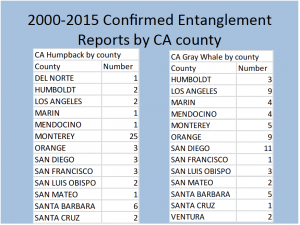
Power Point presentation: Dan Lawson talk, 1.9 MB
